 The prompt for week #9 of the 52 Ancestors/52 Weeks Challenge is CLOSE TO HOME, as in Which ancestor is the closest to where you live? Who has a story that hits “close to home”?
The prompt for week #9 of the 52 Ancestors/52 Weeks Challenge is CLOSE TO HOME, as in Which ancestor is the closest to where you live? Who has a story that hits “close to home”?
What Monica McGoldrick says in her book, You Can Go Home Again, resonates with me, particularly when I think about my mother and her family:
We are born not just into our family, but into our family’s stories, which both nourish and sometimes cripple us. . . . Everything that gets said in a family falls at the intersection of the said and the unsaid. . . . Whatever has happened in your family shapes you. Events that happened long before your birth, never mentioned in your family during your lifetime, may influence you in powerful, though hidden, ways (McGoldrick, 30).
Margarite Mae Witzke, 1899-1966, my maternal grandmother, fits this week’s challenge in the sense that I remember “Grandma Margie”–she’s not just someone in the records, but rather someone I remember as a living part of my family. I would argue, however, that the fact that I knew her doesn’t make my account of her any more “true” than the stories I’ve teased from the records about ancestors I never met. I’ve heard from my mother many stories about Margie and the phases of her life–from young married, to middle-aged widow, to married again, with a second chance. Unfortunately, when Alta tells a story about her family, her telling of it never varies, and the stories have become a series of set pieces that feel narrow and shallow. Just like negotiating the records for ancestors that don’t exist, it can be equally difficult to navigate the stories that are heard too many times. Are the stories true? Maybe not. Do they contain some truth? Undoubtedly.
Margarite Witzke was the fourth of ten children born in Trinidad, Colorado to George Witzke and Emma Baxter Witzke. Her father was a stone mason who immigrated from West Prussia in 1884. Her mother was from a Colorado pioneer family whose father was one of the last buffalo hunters in southeastern Colorado. My mother Alta knew NOTHING of her Baxter grandmother’s family–not even that they lived in Colorado, let alone the story of their pioneer life in Colorado before it was even a state. She knew next-to-nothing about her Witzke grandfather, telling the story over and over that he died of a broken neck when he fell off a scaffolding at work (he didn’t–he died in a car accident). So I have to be careful about what I think I “know” about Margarite–take a step back from those set pieces I’ve heard too many times and try to find the flesh and blood person.
Here’s the only picture my mother ever had of Margie’s family. From the things she said about them, I think Alta was ashamed of them. George and Emma Witzke are standing at the left.
The photo my mother had of her mother’s family was given to her by Margie, her mother. Why was this the only photo she kept or the only one Margie ever showed my mother? Below are studio portraits of George and Emma’s family, part of a lost collection of papers that had been sitting in a garage for decades, photos my mother never saw. I imagine if my mother’s collection had contained any of these photos instead of the candid photo outside of one of George & Emma’s sons houses (she always believed that my grandmother grew up in this “shack” as she called it–it wasn’t even George Witzke’s house), my mother would have grown up with a different impression of her mother’s family. I think that photo colored every story my mother ever told about her mother’s family.
Margie’s father was a stone mason, and he moved the family between Trinidad and Pueblo, Colorado several times during Margie’s young years. It seems that during Margie’s school years the family made several moves. According to city directories, the George Witzke family lived in Pueblo, Colorado from 1904, when Margie was 5 years old, to 1911 or 1912, when Margie was 12 or 13. Then in 1912, the family is in Trinidad, Colorado again, living at 1500 Alta Street (I never knew where my mother’s name came from–Alta. That seems like an odd connection. Maybe Margie just liked the sound of it.) So from birth to age 5 she lived in Trinidad; from age 5 to about age 12 she lived in Pueblo; and from age 12 to her marriage at age 16 she lived again in Trinidad. Any school between age 12 to age 15 or so would have been in Trinidad, Colorado. The 1940 census indicates that she had 3 years of high school. I rather doubt she had more than two years if she was married in the summer of her 16th year. Margie had very neat handwriting, and she certainly wasn’t a stupid person. However, she wasn’t educated, and more than anything that fact left her with few resources to fall back on when she needed them in later years, and I think it also contributed to a lack of self esteem that haunted her throughout her life.
Margie was living in Trinidad when she met young Cecil Denton from La Junta, Colorado, who in 1914, like Margie, was only 15 years old. Cecil’s school days were already behind him, as he was working in Trinidad for the railroad, earning wages like an adult. He left home at the age of 15 and never looked back.
When Margie met Cecil or how long they were engaged is unknown, although it couldn’t have been long if she met him when he first arrived in Trinidad. Pictures of Cecil at that time show him to be a gob smacking handsome young fellow, and he must have swept Margie off her feet–if he had set his cap for her, she didn’t have a chance. They were married while living in Trinidad in the summer of 1916. No wedding photos have turned up so far, although Margie is pictured, below, in her wedding dress. Where exactly they were married is unknown, although it could have been at the ranch of a relative who lived in Vineland, Colorado where her older sister Emma was married a year or so before. The background for the wedding dress photo is curious, but unexplained. I think this unfortunate background helped to bolster my mother’s idea that her mother lived in a “shack.” It’s obviously some sort of farm outbuilding, but why take a wedding portrait with that background?
The young married couple soon followed Cecil’s railroad job to Hutchinson, Kansas. They were to live in small Kansas towns for the rest of their married life. In fact, I always thought my grandmother had been born in Kansas. I had no idea until years after her death that she was actually a Colorado native. The family is something of a mystery, and years of genealogy work has cleared up only some of it. Cecil always had a good job with the railroad, and it’s sort of astounding to me that the big events of the day didn’t ever seem to involve Cecil in a personal way. Because of his “essential” railroad job, he was exempt from being called up in the WWI draft. By the time WWII came around, he was too old to be called, nor did he have a son who was sent to war. The Depression didn’t affect him as it did other middle-class workers his age, since he always had work with the railroad.
Cecil and Margie started off their family right away. Margie had her first child within the first year of her marriage, a daughter named Gladys. A picture of them traveling with little Gladys shows a couple who appear older than their twenty years and also rather prosperous, the mother and daughter trimmed in fur, the father looking serious and dressed for a white-collar job. Cecil and Margie look like they’re going places.
Their second child, a son they called Billy, followed Gladys four years later, and three years after that my mother was born, Alta Louise. Photo after photo of Cecil and his children together show that Gladys and Billy were much-loved by their father. My mother describes her father as “cold,” but pictures of him with his children tell a different story.
Frankly, photos with the children when they were small indicate that the “cold one” in the family might have been Margie. I can testify that she had an odd way with her grandchildren, very formal and chilly, seemingly unwilling to touch or be touched. Pictures show that she might have been the same way with her own children. Invariably she’s standing with the children, not down at their level like Cecil, and her hands are almost always clasped behind her, not settled on the child. There are no pictures in any collection I’ve found of Margie and Billy or Margie and Alta.
It’s reasonable to think that Cecil’s loving demeanor might have changed after the death of Little Billy, who died of pneumonia in 1931 at the age of eight, a family tragedy my mother believes her parents were never able to get beyond. My mother Alta was only four years old when Billy died, so she probably doesn’t remember what her parents were like before his death. It’s telling, I think, that not one picture of Cecil and young Alta exists, unlike the many taken with little Gladys. “Dad loved you best” may, unfortunately for Alta, have been true.
It was around this same time that Cecil was having a rather public affair with the wife of one of his co-workers. The story is odd, and coming from Alta I would question its truth, but the photos seem to show that something was going on between Cecil and a woman who wasn’t his wife. It’s possible that the two couples started out as a foursome–or maybe the “foursome” was cover for Cecil to spend more time with his delightful friend. There’s an odd picture in the collection of Margie and the girlfriend (named Gladys, like her oldest child–an unfortunate coincidence, since Gladys was born long before Cecil met the older Gladys–although there’s another story that my mother told as “true”–that Cecil’s daughter was named for his girlfriend). Margie and the older Gladys are standing together on the bumper of Cecil’s car, and Gladys is grabbing Margie’s hand, maybe to steady herself to keep from falling off. Margie’s head is cut off at the top, and since Cecil was a reasonably skilled photographer, it would seem that maybe Margie wasn’t meant to be the center of attention in the photo.
I’m able to date the photo because of the apparent age of the little girl sitting alone in the background–my mother Alta. Unlike her sister Gladys, of whom I have about 20 pictures at this age with her father, Alta isn’t found in a single photograph with her parents. This day, whatever the four adults were doing on this day, is no exception. The affair, and apparently that’s what it was, seems to have gone on for years. Evidently Gladys wasn’t able to have children of her own, and my mother says that Gladys wanted Alta to call her “Mama S___.” Which begs the question, Where was Margie in any of these pictures with Alta?
The Cecil-Gladys affair had to have ended by 1933 because Gladys was shot dead that year in what the newspapers described as a “love triangle.” Even though Cecil wasn’t named in the newspapers, the scandal surrounding the “pretty 26-year-old divorcee” must have been fierce in their small town. My mother tells the story about being 5 years old (she would have been 8 when Gladys was killed) and “finding a gun” in a closet of their house. The gun was taken from her by her father, who said, “You don’t want that.” Then she adds that her mother used to shake her head and say, “That poor man–the wrong man is in prison”–implying, I guess that someone went to prison in Cecil’s place, wrongly accused? That’s what Alta let me think, which drove me to check out the story in the newspapers. Such a sensational story obviously would be written up in the paper–and it was. The story clearly states that the shooter was known–another “suitor” of the recently-divorced Mrs. Gladys Stitt. The man (not Cecil) shot and killed Gladys and then shot himself in the head. He survived the shooting and presumably (although I haven’t yet found that story) went to prison for murdering Gladys.
It’s little wonder that pictures of Margie during this time show a woman who appears to be terribly sad.
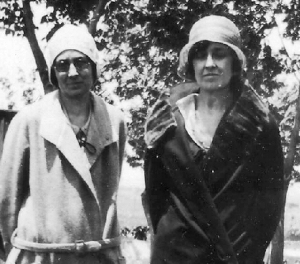
Margie on the left and her sister, Emma Witzke Beecham. Emma and Margie were close at this time in their lives. Emma lived in Newton, Kansas, about 30 miles from Hutchinson, and the families visited frequently.
For some reason, this family never owned a home, but instead made move after lateral move to one rented house after another. Why did this family apparently never have any money despite Cecil’s good job? There must have been hundreds of little houses in Hutchinson that the family could have afforded to buy. My mother says it was because Cecil never wanted to own a house after Billy died, but that sounds like one of those sentimental stories that are designed to cover the truth. She may not have known the truth. My mother very nearly never said anything “real” about her family. Mainly what she said were little set pieces like, “She loved nice things–and she had them,” referring to one of her aunts. The problem with these superficial little aphorisms of hers is that there was never a story behind them–“My dad had a bad temper,” she would say, but I don’t remember her giving one example of what that meant to her; or “My dad liked cars.” Surely a man who doesn’t like cars is more unusual than one who does. Did he buy a car and let his family go hungry?–now that would be a story. But we never get that from Alta. One time Alta said, “My dad liked to gamble.” The “girlfriend” shows that Cecil wasn’t a stranger to risky behavior, so maybe he also gambled with the mortgage money. Maybe he took the train to Reno or Las Vegas instead of taking the family on vacations. It’s an interesting thought, and it might explain why the family never had any money, but I don’t know how it could ever be proven. I only know that in the Reno County courthouse in Hutchinson, Kansas, there’s not a single deed or document with Cecil Denton’s name on it.
Life has a way of moving on, and somehow Margie and Cecil must have moved on beyond the death of their only son and Cecil’s public affair. Whether the tragic ending of the “pretty divorcee’s” life also ended Cecil’s infidelity is unknown. Cecil continued working for the railroad and over the next decade was transferred from Hutchinson to other small Kansas towns and then back to Hutchinson again. Sometimes Margie moved with him; sometimes she stayed behind in Hutchinson. What did she do with herself during these years? According to Alta, Margie wasn’t exactly a maven of traditional around-the-house women’s work. Cecil did all the “heavy” housework, like washing the woodwork. Margie didn’t sew. I never knew her to knit or do any sort of hand sewing.
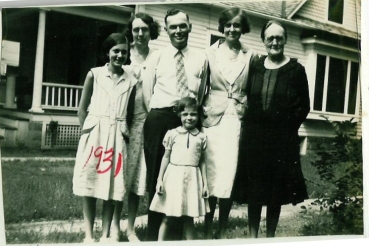
A family visit at Emma’s house. Grandma Witzke, at the far right, was visiting. Margie and Cecil are in the center; Emma is in the back row, left. The little girl in front is my mother Alta. The older girl at the left is a cousin.
The family holidays were spent at her sister’s house in Newton, Kansas, who was a “fabulous cook,” according to my mother. Margie’s contribution to those meals was always the desert. She never seems to have had a garden or to have done any canning. My mother never met a vegetable, other than corn, that she would either cook or eat. Alta said that Margie was a fan of “romance” magazines that she hid in the couch cushions (later, when she would visit us in the 1950’s, no one was allowed to bother her when she was watching “As the World Turns” and “The Edge of Night”). Margie’s sister Emma, on the other hand, was a “joiner”–of groups like the Eastern Star and the Daughters of Union Veterans of the Civil War, and she was also a constant and faithful member of her Baptist church. Margie didn’t go to church.
My mother says that her father loved working for the railroad. I visited Hutchinson, Kansas sometime around the year 2000, and when I was standing in the middle of my mother’s old block, the trains were so loud they literally shook the ground. Granted people living there would eventually learn to tune them out–they would have to. But still the sound of the trains would have been the background music of their lives. This quotation is from a memoir by Brenda Ueland, titled Me. She was about the same age as Margie, so her perspective might be similar:
I think trains to us in the Middle West have the nostalgic romantic connotation that ships have to people on the seacoast. For to us it is trains that mean travel, escape, leaving home, sadness, freedom, adventure. They come from the wild plains of Dakota and Montana, and they go on and on and across the world, and you get on one and perhaps never come back (86).
Because Cecil worked for the railroad, the family had a free pass to ride the train. Margie and her sister Emma are found together in several photos visiting their Colorado relatives. Margie went to La Junta, Colorado in 1926 for her grandfather Alonzo Baxter’s 80th birthday celebration; she went to Salt Lake City, Utah in 1929 to visit her aunt Daisy Jefferson; she went to Trinidad, Colorado in 1930 when her father died; she visited her mother, aunts, and cousins in 1932 in Sioux City, Iowa; she went to Washington, D.C. with her daughter Alta in 1941 to visit her sisters. She visited her daughter Alta and our family in Denver in the 1950s and her daughter Gladys and family in Hobbs, New Mexico. Railroaders like Cecil Denton may not have had a lot of money, but they did have access to transportation and travel, and that access enabled Margie, when she wanted to, to keep up family connections.
Here’s the only picture I have of Margie and her daughters, taken in 1935 when Alta was 10 years old (small for her age). Alta’s sister Gladys is 18, and Margie would have been 36. My mother told me that Margie said the “best year” of a woman’s life is age 35; also, the “first place” that shows aging in the elbow. Oh good grief. It’s difficult to say whether the story demonstrates Alta’s or Margie’s fixation with aging.
Margie’s most abiding social interest during this time,, according to the small-town newspaper clippings, seems to have been her bridge club. From a 1937 Hutchinson newspaper:
“Meet-em-all” is the name chosen for a bridge club organized yesterday in a meeting in the home of Mrs. C.W. Denton, 1807 East Fourth st. Mrs. Francis Beacham of Newton and Mrs. Ridlen and Mrs. Brownlee were guests.
There are countless references from 1937 to the early 1940’s in the Hutchinson newspaper to this and other bridge groups, where “Mrs. C.W. Denton” is featured as the hostess or as the winner of prizes given by the club. Obviously in bridge, Margie had found something she truly enjoyed.
The photos above show Margie between about 1937 and 1943, “the bridge years.” The body language in the earlier photo with Cecil is pretty grim. The second later photo is with Margie and two of her sisters–Margie, Dot (or Dorothy, a younger sister), and Emma (her oldest sister). I’m dating the second photo as the summer of 1940 (it wasn’t taken after Labor Day because Margie is holding a white purse–and she would never have carried a white accessory or worn white shoes after Labor Day). Margie had put on weight in this photo since the 1935 photo with her daughters. Emma sewed her own clothes, which is pretty obvious, judging from the dress she’s wearing. It also looks as though Dot’s dress was made from the same (rather horrifying) pattern as Emma’s. The “bias cut look” of Dot’s and Emma’s dress was popular in 1940 but went out of style with WWII because the bias cut used more fabric. Dot’s hat is very much like one found in a Sears catalog for 1940. The brim and the trim look similar to a hat called the “Wing Clipper.” Margie’s look is more up-to-date (although it certainly can’t be said that she ever “did” hats well, including here). Since she couldn’t sew, according to Alta (or possibly wouldn’t sew may have been more likely), then her dress was store-bought. I hope Margie didn’t look down on her sister Emma for her homemade small-town Kansas look, but I imagine she might have.
Margie’s two daughters were eight years apart–Gladys eight years older than Alta–and the gap might as well have been eight light-years. My mother says, without elaboration, that she had “about five” conversations in her lifetime with her sister. Obviously that’s hyperbole, but it’s probably a good indication of how she felt about her emotional connection with her sister Gladys. By 1940, Gladys was married to her long-time boyfriend Chuck; Alta, on the other hand, was 14 years old and just entering high school. She was beautiful, bubble-headed, and absolutely boy crazy. She wore a rat in her hair and was experimenting with dime-store lipstick and eyebrow pencil. Alta looks several years older than her same-age best friend in this drugstore booth photo–the two photos taken on the same day. I imagine 14-year-old Alta was the kind of girl who smuggled her makeup out of the house when she went to school in the morning and then plastered it all over her face whenever she got where she was going. She sure as hell didn’t tell Cecil goodbye in the morning wearing “Eternal Wound” lipstick smeared all over her face.
But that was part of the problem–Cecil was mostly AWOL during his younger daughter’s high school years, since his job took him to Dodge City most of the time. Margie was left to deal with this handful largely on her own, which she doesn’t seem to have done very well. From reading the diary that Alta kept during those years, it’s pretty clear that Alta had too much freedom between school and home, at school, at home, and everywhere in-between. No adult seems to have been looking out for her–or expecting much of anything from her. All during high school, she doesn’t seem to have had a curfew and she doesn’t ever seem to have to answer to anyone. Her diary shows her working at the Fox Theatre as an “usherette,” frequently until 11:00 at night on a school night. This was a girl who really couldn’t afford spend any less time on her studies, although her perfect unconcern is evident over her “grewsome” grades:
Wow! I got my grade cards today. I didn’t study one bit this six weeks. Gosh I went down in everything I’m taking. I got a B in Typing, a C in history, a D in Shorthand, & a B in Constitution. I really should do a lot better in History. I wasn’t surprised about Shorthand though.
Margie’s last move with Cecil was in 1943, when Cecil was promoted in his railroad job. With the promotion went a another move to another small Kansas town, Chanute, Kansas. Cecil moved there first, in January of 1943, while Margie and Alta stayed behind for Alta’s senior year of high school. Margie would travel to Chanute to see Cecil, leaving Alta behind by herself. On a Thursday night during her senior year she had a date with a cadet (“not very cute”) and went dancing after work that night at the Brown: “Gosh at least they really spend the money on you.” It wasn’t unusual for her to stay out until 1 or 2 a.m. on a weeknight. On Sunday she writes, “Mom’s in still in Chanute, so I’m not going to school tomorrow.” Then later, “I talked to Dad long distance tonight. He wants me to come to Chanute next weekend beings I didn’t go this weekend. I sure would like to but it’s an awfully long trip.” Sure would like to? Many entries are like this one: “Mom was gone so I had some kids up. The same old tribe.” It seems like some kind of miracle that she graduated from high school, and she evidently thought so too: “I graduated tonite. I really didn’t think I’d make it but I did.”
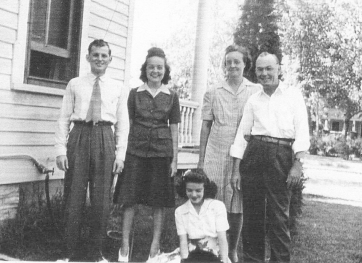
May 1943. Gladys and her husband Chuck; Margie and Cecil; Alta (sitting on the ground with Gladys’s dog). This is probably the last photo taken with all of them together.
It was here less than a year later at the age of 44 that Cecil died of a heart attack. Margie and my mother, 19 years old and at rather loose ends because of the war, and seemingly no less bubble-headed than during her high school years, moved back to Hutchinson and roomed together as “working girls,” Alta working at the Naval Air Base and Margie working as a clerk at the Hotel Bisonte. As far as I know, Margie had never had a paying job before Cecil died in 1944. It’s reasonable to assume her task of finding work was made easier because her daughter’s mother-in-law, Dimple Embick, was the manager of the Hotel Bisonte. The base closed in 1946, and the daughter moved on to Denver, looking for new horizons. She was the last of her “tribe” to marry, and I think Alta Denton was in panic mode–but this is Margie’s story, not hers.
I know very little about Margie’s life in the decade of 1945 to 1955. Likely enough she remained in Hutchinson, working at the hotel. Her younger daughter Alta got married in Hutchinson in 1948 and started her family in Denver.
The relationships with her sisters would eventually fall apart, even her relationship with Emma, probably due to the tension everyone felt about caring for their aging mother. However, as of 1953, Margie was at least still speaking to the older sisters. This was a visit at Emma Witzke Beacham’s house (who else?) in Newton, Kansas in the summer of 1953. From left to right: Margie, age 54; Erne, age 62; Emma, age 59; and Leona, age 51. I think my mother took this picture of her aunts. She was never able to frame a shot, always cutting off someone. Margie doesn’t look like she’s exactly the life of the party here.
Perhaps the marriage of her youngest daughter gave Margie the space she needed to think about her own life. Sometime around 1955, she met a man named Henry Eston Lovelace (always pronounced “Loveless” by my grandmother). Henry was from rural Georgia. The same age as Margie, he was working as an Engineer for the Highway Department in the 1940 census, married to Eleanor, with three young boys. Curiously, both Margie and Henry are found in the 1955 Wichita, Kansas City Directory. I say “curiously,” because Margie and Henry were married in Wichita on 5 Sep 1955.
Denton, Margt M desk clerk McClellan Hotel r110 N Estelle
Lovelace, Henry E (Eleanor) clk Wilson & Co r229 E William
Henry and his first wife Laura Eleanor McLaughn were divorced in Tuscaloosa County, Alabama in May of 1955. I found the newspaper clipping of Margie and Henry’s marriage announcement saved in Margie’s wallet, which was given to me by Gladys’s daughter just a few years ago:
Henry E. Lovelace, Mrs. Margaret Denton (9/3/55)
Mrs. Margaret Denton of Wichita, formerly of Hutchinson, exchanged marriage vows with Henry E. Lovelace of Tuscaloosa, Ala., in a 3 p.m. ceremony Saturday. Rev. David Miller officiated in the Presbyterian manse in Wichita. Among wedding guests were the bride’s daughters, Mmes. C.W. Embick and family, 226 West 17th, and R.K. Roorda and family of Denver.Mr. Lovelace is employed in Wichita as a construction engineer, and his bride is employed there by the McClellan Hotel. After a short wedding trip they will be at home at the Shirkmere Hotel, Wichita.
Well then. . . that’s a story I never heard my mother tell. I don’t remember knowing that Henry had been married before, and I know it was never mentioned that he was divorced shortly before he and Margie were married. What I remember is that his job caused him to travel, and he had met Margie at the hotel where she was working. How long had Henry and Margie been “seeing” each other before they were married? I also never knew that my mother attended Margie’s wedding, because she never mentioned it–not once. I wonder why Margie carried that newspaper clipping in her wallet?
The dates aren’t really clear to me, but Margie & Henry moved from Wichita, Kansas to Kansas City to Albuquerque, New Mexico. I think the move to Albuquerque came after 1960. Henry’s funeral announcement states that they had lived in the city for three years before his death, so they must have moved there in about 1962. This photo below was probably taken in K.C. One thing about Margie after she was widowed the first time: she was always and forever impeccably dressed. She would visit us once in awhile in Denver, taking the train from Kansas, and I remember she would get off that train looking like a million bucks. She liked nice clothes, and after the Hutchinson years when there doesn’t seem to have been money for anything, she had them.
Here’s another “classic” picture of Margie around this time–in 1959 at her home in Kansas City. She’s holding candy in one hand (she had a terrific sweet tooth) and a handkerchief in another. And always, always dressed up. She was 60 years old.
Looking at things with an outsider’s perspective, life with Henry Lovelace probably didn’t go easily or particularly well. Like a lot of people of his generation, Henry was a lifelong smoker. I also suspect he did his share of drinking–and it’s certainly possible that Margie joined him. In 1960, he was 60 but he looked closer to 80. I don’t imagine Margie had an easy time of it with him.
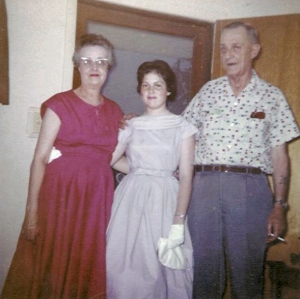
1960. Margie and Henry, visiting with Margie’s daughter Gladys and her family. This is Gladys’s daughter, her only child. Henry was only 60 years old. He probably already was suffering from the emphysema that would be the cause of his death five years later.
It may have been Henry’s illness that kept Margie from attending her mother’s funeral in Florida in 1962–or it may have been something else. Her mother, Emma Baxter Witzke, was living in Florida at the time of her death with several of Margie’s younger sisters. Emma had been a widow for a long time–since 1930 when her husband was killed in a car accident. From that time, on, for the next 30-plus years, Emma lived with the families of her children, seemingly on a rotating basis. Emma never seems to have lived with Margie; I don’t believe I’ve ever seen a picture of the adult Margie and her mother, except for the group picture of the siblings surrounding the mother at their father’s funeral. It’s easy to imagine that Margie’s non-participation in Emma’s care would have been a source of friction between Margie and the siblings who were contributing. The stories about Emma Baxter Witzke that people tell indicate she must have been a difficult person. She was Irish, and it’s said that she never forgot a slight or let go of a grievance. My mother called her mean and grim. A daughter of a one of Margie’s brothers used the word “vengeful.” This woman wrote:
Grandma Witzke actually caused my mom to have a nervous breakdown. When that happened, Daddy put his foot down and called his sisters, telling them they were going to have to take care of her. My mom flew with her to Florida where several of the sisters were living, and that is where she died several years later. Daddy and Mom weren’t even notified of her death until after she was buried. Grandma wanted to be buried next to her husband George Witzke in Colorado; however, the sisters in Florida didn’t honor her request, burying her in Florida instead.
I wish I had input from someone in the sisters’ families about Emma Witzke. They would undoubtedly be able to round out the Emma’s portrait. However, since my grandmother had broken with those sisters, my mother didn’t know them either. I’ve tried to contact some of the sisters’ children, but so far with no success.
There’s an interesting photo of the sisters together at Emma Witzke’s funeral (with her open casket in the background). The brother who wasn’t notified of her death obviously isn’t there, and neither is Margie (actually Margie and all three brothers are missing). Is that how they got back at Margie for not helping with her care–by also not letting her know that her mother had died? If so, the “vengeful” gene was evidently passed from mother to daughters. Burying Emma in Florida against her wishes to be buried with her husband in Colorado seems pretty vengeful as well.
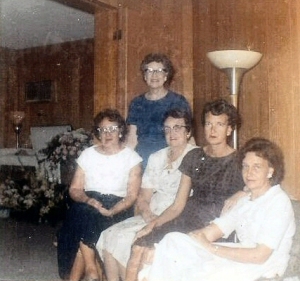
The “vengeful” sisters? Dot, Emma, Vi, Nina, and Leona. The only one I knew was Emma. The open casket is in the background.
Obviously there were hard feelings among the “Witzke girls” by the time the mother Emma Witzke died. At some point, Margie and the sister who had always been Margie’s ally, Emma Beacham, also had a falling out. Margie may have been mad at her sister Emma for not telling her about their mother’s death–who knows? I know for certain that Margie told my mother not to tell Emma that she was ill, and my mother went along with her wishes. Margie evidently told her daughter Gladys the same thing. When their mother died, Gladys wrote this to my mother:
Got a note from Emma to-day–Mother would not let me write to her to tell her she was sick–don’t have any idea what the fight was about but Mother wanted nothing to do with her. Have not heard from any of the others [Margie’s other sisters]–and don’t suppose I will–I was not one of their favorite people–too much Denton and not enough Witzke, I guess.
When Emma Beacham found out that Margie had died, and she hadn’t been told even that she was ill, she never spoke to my mother again. Very sad.
It took me a long time to figure out that Emma Witzke was Irish, hiding out in the genealogy as she was under the Witzke name. Her great grandfather James Baxter and his wife came from Tyrone Ireland. There’s a wonderful book for anyone trying to understand their Irish roots: Irish America: Coming into Clover, The Evolution of a People and a Culture, by Maureen Dezell. She writes:
Ostracization and silence are acceptable ways of showing disapproval in many Irish families, a social unit often noted for both its extraordinary loyalty and willingness to cut off relationships abruptly and completely. If someone does something wrong in an Irish family, the rest of the family just stops talking to them. They don’t talk to you. If they did, they would have to tell you what was bothering them, which would mean letting down their defenses. Irish grudges go on so long that people forget what they were about to begin with (Dezell, 116).
Henry Lovelace died of emphysema in Albuquerque in June of 1965. Henry had served in the Army during WWI, so he was eligible to be buried at Fort Logan Cemetery in Denver. Margie stayed with us when she came to Denver to bury him.
The above is one of the last photos I have of Margie, showing an unusually thin version of her. I remember someone teasing her about not wanting to hold my baby brother because he would wrinkle her dress. It was good-natured teasing, but it was also true. I don’t know if we were aware at that visit that she was ill, but I think so, although my mother kept up a fierce denial all through the last months of her illness. I remember that Margie was seeing a chiropractor for a “pain” in her side, and I think my parents tried to convince her to see a medical doctor. She was eventually diagnosed with liver cancer and died the following March. She was buried with Henry Lovelace at Fort Logan. I don’t know if there was a discussion about burying her beside Cecil Denton and her son Billy at the La Junta, Colorado cemetery. I wish she had been buried with Cecil, and perhaps a marker should be placed there in her memory. Gladys wrote this in a letter to my mother:
We had the back bedroom fixed after Henry died and wanted her to come here but she wanted a place of her own. She could have been happy here but something held her back. I loved her very much. She just wouldn’t let me love her like I really wanted to all my life–didn’t have time for me. But I’m rambling and tired–must go to bed.
I’ll close out Margie’s story for now with this, again from Maureen Dezell:
Irish women tend to think they have to do it all themselves. Too often, lives become an exercise in ‘trying to keep a lid on things.’ So they become stern and demanding, resentful and self-righteous. They feel they have to tolerate men and keep them under control, and that means blocking off feelings. There’s a fear of intimacy–and these women lose touch with their tenderness at times (Dezell, 114).
Understanding Margie from the point of view of her Irish side would go a long way to explaining Margie’s emotional makeup. Margie’s long-suffering, silent, “making-the-best-of-it” attitude towards Cecil and his affairs and towards others in the family would fit Dezell’s discussion of the Irish woman’s view of the world. Everything I know about Margie, every experience I had of her–the anxiety, the emotional distance and stand-offishness, her dour demeanor–all of that could be better understood, I think, by looking at her through this Irish lens. I wish her life had been happier.
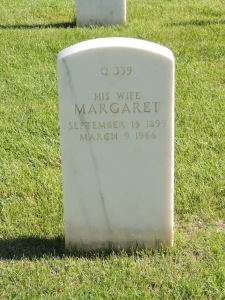
Margaret Lovelace, buried with Henry Lovelace at Fort Logan National Cemetery, Denver, Colorado. I don’t remember any discussion of Margie being buried in La Junta, Colo. with Cecil Denton and her son Billy. There is an unused grave plot in Fairview Cemetery in La Junta next to Cecil and Billy.
Sources
Dezell, Maureen. Irish America Coming into Clover: The Evolution of a People and a Culture. Doubleday, NY, 2000.
McGoldrick, Monica. You Can Go Home Again: Reconnecting with Your Family. WW. Norton Co., NY, 1995.
O’Brien, Sharon. The Family Silver: A Memoir of Depression and Inheritance. U of Chicago P, Chicago, 2004.
Ueland, Brenda. Me: A Memoir. Holy Cow! Press, reprint edition, 1996. Originally published 1939.


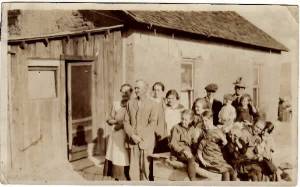
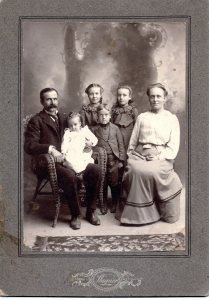
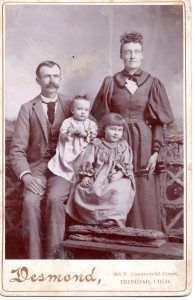
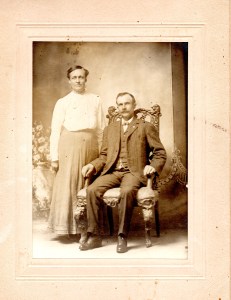
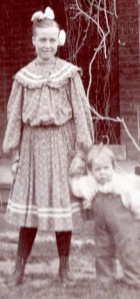
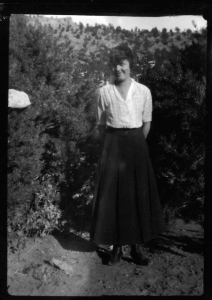
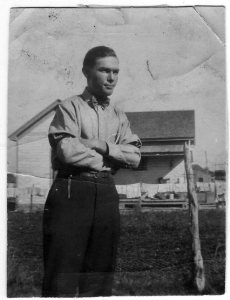
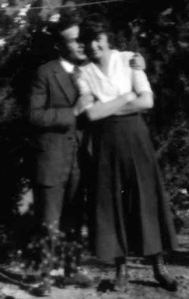
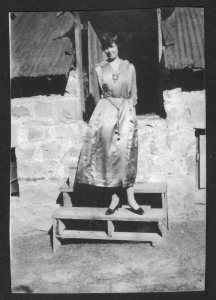
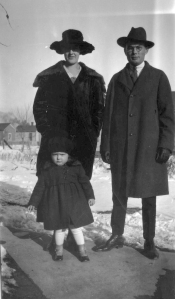
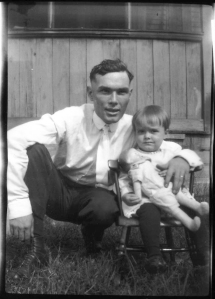
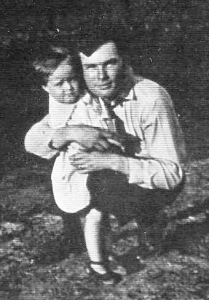
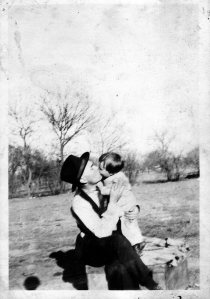
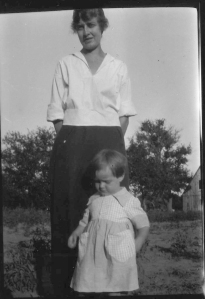
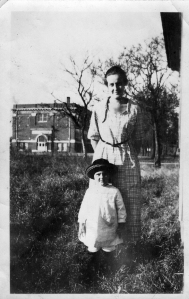
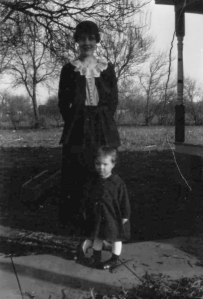
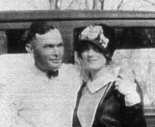
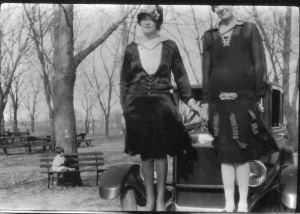
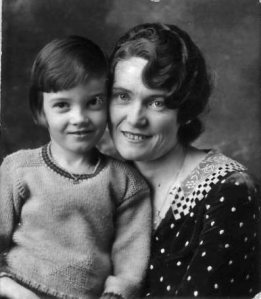
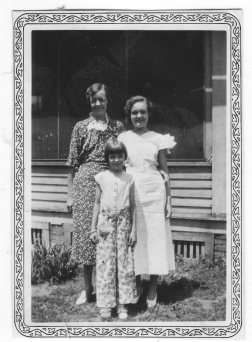
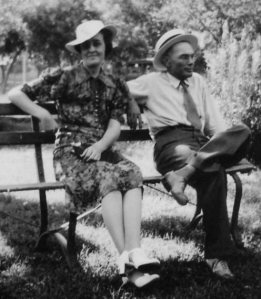
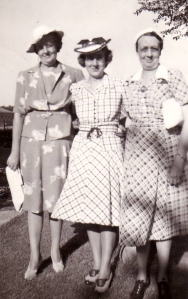
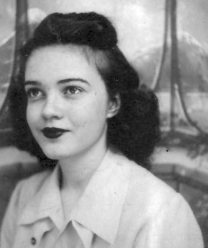
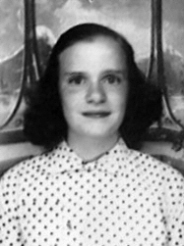
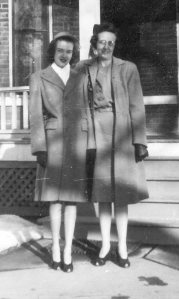
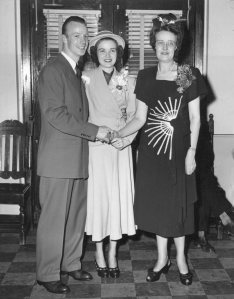
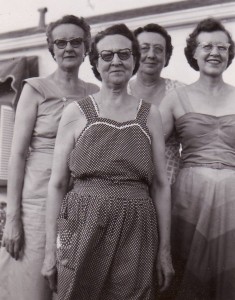
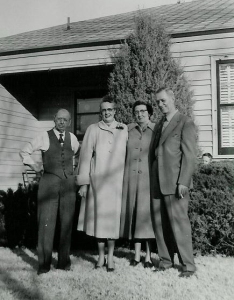
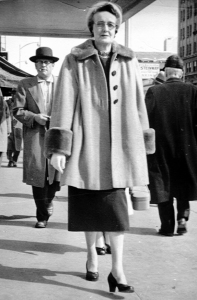
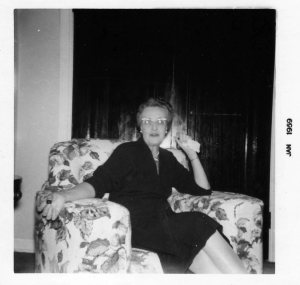
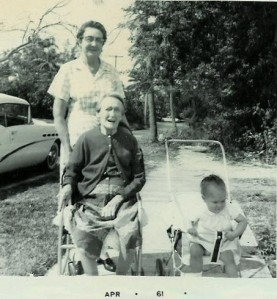
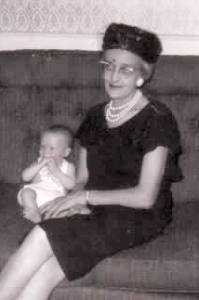
I really enjoyed this post. I am always hoping to find people who can give me eyewitness accounts of deceased family members but it’s true that one person’s version of events will never tell the whole story. Also, the ancestors we met as children will always be old to us and it is difficult to give them a life before we knew them.
It’s also really interesting that your mother based a lot of what she believed about your grandmother from that one photograph like that photograph captures everything about her.
The photographs with her children do seem to tell a story though – with the same pose in each one. Or maybe she was just self concious about posing.
Your grandmother suffered a great loss in her life and that is bound to have an impact. When I think of the tragedy my great, great grandmother suffered I am surprised she managed to function at all.
I look forward to reading more.
LikeLike
Pingback: Henry Eston Lovelace, 1900-1965 | The Shoebox Under the Bed